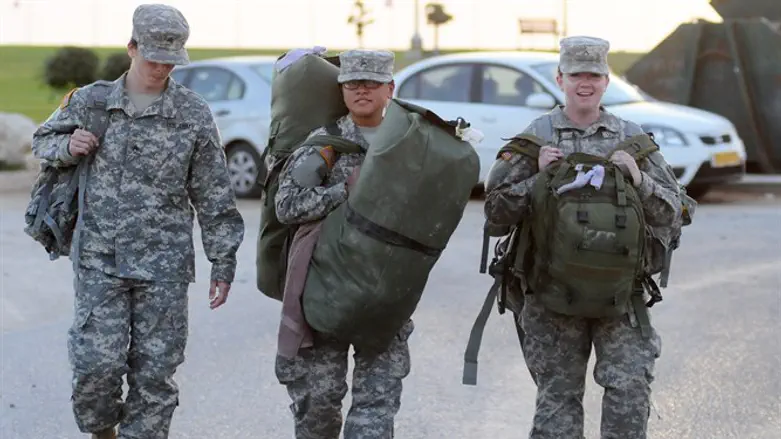
(JNS) During his Senate confirmation hearing, Defense Secretary General Lloyd Austin gave an ominous description of how he viewed the Pentagon’s mission. He began his statement blandly enough.
“The job of the Defense Department is to keep America safe from our enemies,” he said.
He immediately added, however, “But we can’t do that if some of those enemies live within our ranks.”
Upon entering the Pentagon a week later, Austin issued a 60-day stand-down order to all units in the U.S. Armed Forces to enable commanders to deal with “the enemies within our ranks.”
Those were the days of hysteria that followed the so-called “insurrection” or “occupation” of the Capitol by supporters of former President Donald Trump on Jan. 6. The protesters were castigated as “domestic terrorists” who pose an “existential threat” to America as a constitutional republic. Thousands of National Guard troops were mobilized to protect the Capitol. And America’s “People’s House” took on the appearance of a military base or a prison as barbed wire fencing went up to protect it from the people.
The protesters who entered Capitol Hill on Jan. 6 were hunted down and arrested by federal authorities. Most of those arrested remain incarcerated to this day despite the fact that they haven’t been tried, many haven’t been indicted, none are accused of serious violent crimes and most have no criminal record.
The only person who died a violent death on Capitol Hill on Jan. 6 was a protester. Air Force veteran Ashli Babbit was shot to death by an undercover Capitol Police officer. The officer’s identity has never been revealed. The investigation of his actions was closed without any disciplinary or legal action against him.
Although all of these facts lend to the sense that the rantings about an “insurrection” were entirely wrong, Austin and his generals insist that the events of Jan. 6 were every bit as terrible and dangerous as they were touted to have been by the media and Nancy Pelosi.
Although no evidence has been presented indicating the protesters were at the Capitol to advance a white supremacist agenda, Chairman of the Joint Chiefs of Staff Mark Milley intimated in congressional testimony that the Capitol Hill protest was informed by white supremacy.
Austin, Milley and their colleagues are using the misrepresented events of that day as an ongoing justification of their efforts to purge the U.S. military of the “enemies within the ranks.”
A key component of the purge is indoctrination. Officers and enlisted soldiers, airmen, sailors and marines are now compelled to study and internalize progressive texts and other materials that are aligned with Critical Race Theory. As army veteran Sen. Tom Cotton (Ark.), defined the term in an article in National Review, “Critical race theory repudiates the principle of equality under the law that is articulated in the Declaration of Independence and that has motivated civil-rights reformers for generations. It claims that this American ideal is a sham used by the white majority to oppress racial minorities, and consequently that America is racist to its core. The theory concludes that the only way to end perceived discrimination against racial minorities is to systematically discriminate on their behalf.”
Amidst the public outcry following the Joint Chiefs’ decision to compel servicemen and women to undergo CRT training, Cotton and Rep. Dan Crenshaw set up a “whistleblower hotline,” for service members who feel assaulted by the indoctrination.
In a hearing before the Senate Armed Services Committee last month, Cotton presented some of their findings to Austin. The hundreds of complaints the two lawmakers and veterans have received read like testimony from Stalin’s purges or Mao’s Cultural Revolution.
Required “anti-extremism” training includes segregating soldiers and officers by their skin colors and genders. White men are required to apologize for their physical attributes to those of different races and genders. Senior officers instruct their soldiers that “the U.S. Army is a racist institution.”
Soldiers are taught that police forces are systemically racist and violently inclined against minorities. They are taught that whites enjoy “privilege” by dint of their pigmentation and as a consequence, they must take a back seat to non-whites and willingly accept discrimination against them in the interests of “equity.”
The indoctrination isn’t limited to training sessions. It extends as well to reading lists for service members. Admiral Michael Gilday, the Chief of Naval Operations, distributed a reading list to all naval personnel that includes books calling for the eradication of capitalism and the prohibition of interracial adoption, among other things. The books on Gilday’s list castigate the United States as inherently and irredeemably racist and evil. Required reading lists for or cadets at military academies include similar texts.
Cotton told Austin that as a result of the widescale political indoctrination, “We’re hearing reports of plummeting morale, growing mistrust between the races and the sexes where none existed just six months ago, and unexpected separations and retirements based on these trainings alone.”
Unfortunately, nothing happens in a vacuum. While the Joint Chiefs wage their war against their political enemies within their ranks, America’s actual enemies are becoming increasingly aggressive and emboldened.
This week a Chinese government-controlled magazine published a three-stage plan for invading and conquering Taiwan. This was the second war plan for invading Taiwan published by a Chinese government publication in the past year. Even though U.S. power in the Pacific is predicated in large part on America’s commitment to an independent Taiwan, the Pentagon has no clear strategy for defending the island democracy. It also lacks a strategy for enabling Taiwan to defend itself.
America’s allies in Asia are increasingly open in expressing their concern about America’s lassitude. In a stunning address before the Hudson Institute last month, Japan’s Deputy Defense Minister Yasuhide Nakayama warned his audience that the hour is late and that the U.S. must work with Japan to develop a strategy to defend Taiwan. He concluded his remarks by half begging, “Wake up. We must wake up.”
Precisely what is it that the U.S. needs to wake up to notice? Among other things, the Chinese navy. Earlier this week, Democrat Congresswoman Elaine Luria, a retired naval commander, noted in the Wall Street Journal that whereas in 2010, the U.S. Navy had more ships than China, today, the Chinese navy is larger than the U.S. Navy. Rather than bridge and surpass the divide, the navy continues to retire ships far faster than it procures them. Luria warned that there is no correlation between the Pentagon’s procurement plans for the Air Force and Navy and their strategic mission of defending the U.S. from China.
Luria criticized Milley’s efforts to downplay the seriousness of China’s offensive plans in relation to Taiwan, noting that Adm. John Aquilino, the Pacific combatant commander, views the situation with much greater urgency than Milley.
Last month Milley told Congress, “I think the probability [of a Chinese assault on Taiwan] is probably low, in the immediate, near-term future.”
Aquilino in contrast said China could be prepared to attack Taiwan in the next six years.
“We’ve seen things that I don’t think we expected, and that’s why I continue to talk about a sense of urgency,” he said.
China is not the only U.S. enemy the Pentagon is not taking seriously. Last week, Austin and Milley withdrew all U.S. forces from Bagram Air Base in Afghanistan. Bagram has been the most important U.S. base throughout the long U.S. war in that country. While secrecy may have been called for to protect the retreating troops, the Americans didn’t inform their Afghan counterparts of their plans. The Afghan commander had no opportunity to organize to take control of the base—and the massive amount of military equipment the Americans left behind. As a result, as soon as word got out that the U.S. forces had abandoned the post, mobs of looters descended on Bagram and stole everything in sight.
From a strategic standpoint, the U.S. withdrawal from Bagram left Afghan forces without support, without the requisite training or capacity to defend either the base or themselves. Unsurprisingly the Taliban took the move as a sign that they had won. And they wasted no time running to the real boss in Afghanistan for instructions.
After word broke of the U.S. withdrawal from Bagram, Taliban leaders flew to Tehran to meet with the commanders of Iran’s Revolutionary Guard Corps.
The U.S.’s deterrent posture in the Middle East has sunk to new lows since Joe Biden entered office. In response to attacks on U.S. forces in Iraq by Iranian-controlled militias, Biden ordered airstrikes along the Iraqi-Syrian border on two supply bases that serve the militias. As Dalia al-Aqidi noted in Arab News, the faraway bases have little impact on the militias’ operational readiness or capabilities. Bombing them was little different from bombing empty buildings.
Iran and its proxies wasted no time demonstrating that the U.S. airstrike left them undaunted. Last week saw a cascade of attacks against U.S. forces, allies and installations in Iraq and Syria. Missile and drone strikes on U.S. forces in Erbil were followed by similar attacks against the U.S. Embassy in Baghdad. On Tuesday, U.S. forces guarding the oil fields in northeastern Syria and U.S. forces in Basra were attacked on Wednesday and Thursday. The suspected perpetrator of the bombing of the tanker in the port of Dubai that rocked the city Wednesday evening is Iran’s Yemeni Houthi proxy.
All this points to the conclusion that Iran is certain that the U.S. will not lift a finger to defend itself, fearing that doing so will jeopardize its efforts to realign its policies towards Iran.
The day after he ordered the bombing of the militia bases along the Iraqi-Syrian border, Biden met with Israel’s outgoing President Reuven Rivlin for a farewell visit. In their joint Oval Office appearance, Biden read all of his talking points from cue cards he held in his hand, including the greeting, “I want to thank the president for being here.”
Biden also read, “Iran will never get a nuclear weapon on my watch.”
A few days after Rivlin’s visit, U.S. Secretary of State Antony Blinken withdrew economic sanctions the Trump administration placed on three Iranian nationals involved in the regime’s ballistic missile program. The administration also acknowledged to reporters that it is considering removing the sanctions the Trump administration placed on Iranian leader Ayatollah Ali Khamenei following the Iranian downing of a U.S. drone in the Persian Gulf.
As for Israel, whereas a couple weeks ago, Blinken was telling Foreign Minister Yair Lapid that the administration would account for Israeli concerns about the nuclear deal in its nuclear talks with the Iranians, on Wednesday Haaretz reported that a senior U.S. official admitted Israel has no influence on U.S. negotiating positions in relation to Iran and its nuclear program.
The Bennett-Lapid government’s assumption that it can trust the United States to defend Israel’s strategic interests in relation to Iran and other regional issues is the anchor of its strategic calculations. Given the Pentagon’s current priorities and its strategic disarray in the region, the government would be well advised to revisit that assumption.
Caroline Glick is an award-winning columnist and author of “The Israeli Solution: A One-State Plan for Peace in the Middle East.”
